Sounds good – LD Systems’ “MAUI 11” compact column powered PA system – Test Report by tools4music
The hometown of Adam Hall, distributors of the LD Systems brand, is nicknamed the “cloverleaf city”. An apt description of Neu-Anspach, a small town with four districts in the German state of Hesse. Nestled in the lovely Taunus Mountains, more properly in the northern Taunus, as those familiar with the place will tell you, it is a good 35 kilometres north of Frankfurt. In this issue of tools, however, we are not out to give you tips for hiking through the Taunus. Instead, we want to shed some light on our test candidate for today: the newly unveiled “MAUI 11” by LD Systems.  “MAUI”? Haven’t we heard that somewhere before? A little over a year ago, LD Systems introduced the “MAUI 28” column system which, according to the manufacturer, quickly became a top seller. This success motivated the developers and designers to market a smaller, compact and yet powerful system in the form of the “MAUI 11”.
“MAUI”? Haven’t we heard that somewhere before? A little over a year ago, LD Systems introduced the “MAUI 28” column system which, according to the manufacturer, quickly became a top seller. This success motivated the developers and designers to market a smaller, compact and yet powerful system in the form of the “MAUI 11”.
The “MAUI 11” (“MAUI”, by the way, stands for “Multiple Array User Intuitive”) is an active, 2.1column PA system. It consists of an upright compact subwoofer (17.1 kg) with a mid/high-range column speaker that plugs into the top. The plug-in connection takes the form of two strong metal pins and holds the approx. 1.30 m long, 6.8 kg aluminium column securely in its socket. Simultaneously, the electrical connections are also established when the parts are plugged together, permitting the amplifier signals to pass unimpeded from the amplifier module in the subwoofer to the column. This plug-&-play principle without the use of speaker cables permits rapid setup and above all a significant reduction in transport dimensions, since cables and stands are unnecessary with the “MAUI 11”. The numerals in the model designations “MAUI 28” and “MAUI 11” denote the number of speakers installed. Thus the “MAUI 11” contains a total of eight 3-inch drivers (neodymium), one 1-inch tweeter (neodymium), and two 6.5-inch subwoofers (ferrite).
Long
While the aluminium speaker column is quite light and, with its nearly square cross-section of 94 x 95 mm (W x D), is optically divided into two sections, it actually consists of a single unit. That is regrettable, since a two-part system would be easier to transport. In terms of frequency response, the “MAUI 11” column is divided into three areas. Down below, the mid-range frequencies (180 Hz to 1200 Hz) are transmitted with 70 watts RMS. Above this is a section with 70 watts RMS dedicated to the upper mids (1200 Hz to 7000 Hz) and the tweeter, which is enthroned above all the rest and intended to cover the spectrum from 7000 Hz to 20 kHz.
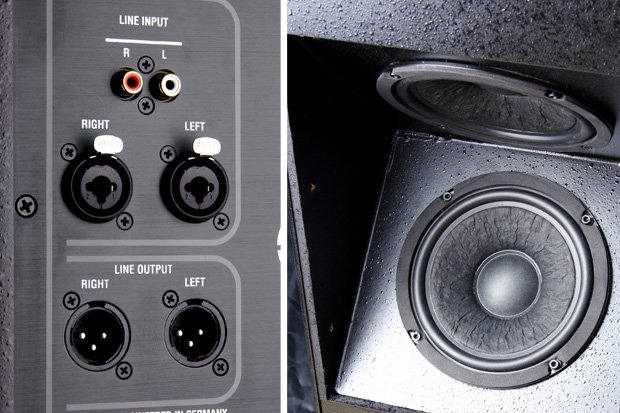 Slim
Slim
While the column speaker makes corresponding demands in terms of space if only because of its length, the bass-reflex subwoofer is almost a “throw-in”. It is light, compact, and also easy to transport thanks to its small dimensions of just 256 x 650 x 355 mm (W x H x D). This is ensured last but not least by the top-side handle.
The subwoofer cabinet houses the electronics with the amplifiers. The subwoofer itself has an output of 200 watts RMS, which ensures plenty of low-end via two 6.5-inch bass speakers. The share of bass in the overall sound is conveniently adjustable from above with the sub-level control. The main level control for the overall volume is also accessible from above.
Removing the sturdy front grille reveals that the two bass speakers are arranged in a “V” configuration. Like with a “V”-type car engine, this enabled designers to keep the cabinet compact. Digital signal processing (DSP) with limiter, equalizer, compressor, and crossover functions provides for clarity and the powerful sound of the overall system.
The indicator lamps are also visible from above, which is very practical. They keep you informed about the switching status (On), the connected audio signal, the limiter, and the protection circuit (Protect). All other connections are located on the rear panel of the subwoofer. There we find the lighted mains switch, a lockable power connector, and of course the input and output sockets. Two XLR/TRS combo sockets serve as line inputs; in addition, there are two RCA inputs. The input signals are passed along via two XLR outputs. There are no fans or cooling fins. Instead, small slits at the top and bottom of the panel provide for the necessary air circulation. A glance “under the hood” reveals, among other other things, how small the aluminium cooling plates (on the left side) can be with a Class D power amplifier.
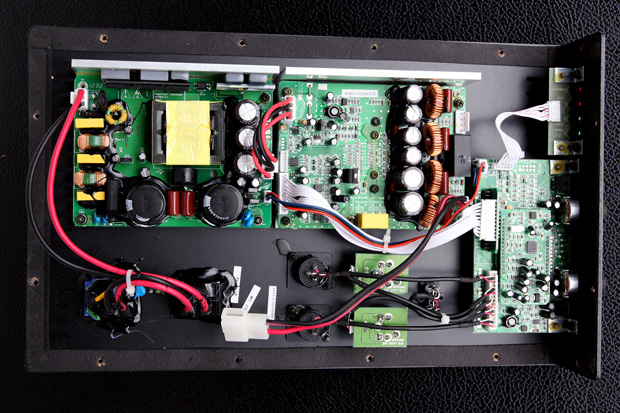 Connected
Connected
Setup is a matter of seconds. There’s nothing to screw up – plug together the two elements, and you’re ready to go. The power amp inputs are line-level inputs. For this reason, you can’t connect dynamic microphones to them directly. That requires a mixer or a preamp. But first I grab some Kenny Wayne Shepherd from my CD collection. An older, 1995 CD entitled “Ledbetter Heights”.
At the time it was recorded, the blues-rock stylist was just 18 years old and displayed a command of his axe on a par with many a veteran guitar slinger. Stevie-Ray-Vaughn-style Stratocaster licks literally jump in my face. The sometimes extensive guitar passages with blues feeling and a touch of soul sound outstanding. It’s not until you back away from the “MAUI” a little, however, that the sound resolves itself accordingly and melts into a unified whole. If you stand too close to the column, the tweeter is extremely noticeable. It is astounding how much rich bass response the two “V” speakers can produce. Depending on the source, it may even be necessary to turn the bass control a little to avoid too much of a good thing.
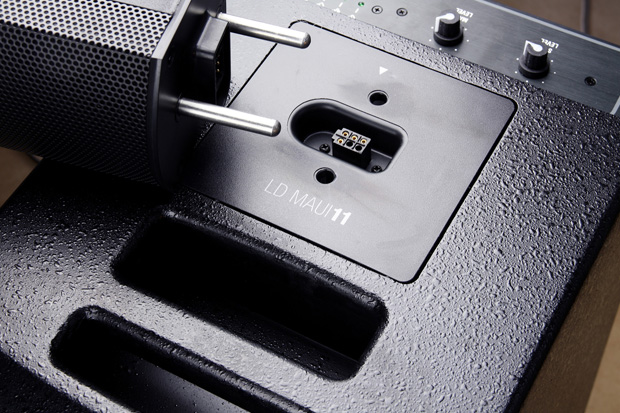 Next up, it’s Tom Petty’s turn. The old album “Wildflowers” (1994) was his second solo release. Of course, this not only represents a different style. It was also produced differently than Shepherd’s Strat orgy was: with lots of acoustic guitar and vocals that convey closeness and intimacy. Petty’s album also sounds finely resolved with a rich foundation.
Next up, it’s Tom Petty’s turn. The old album “Wildflowers” (1994) was his second solo release. Of course, this not only represents a different style. It was also produced differently than Shepherd’s Strat orgy was: with lots of acoustic guitar and vocals that convey closeness and intimacy. Petty’s album also sounds finely resolved with a rich foundation.
Finally, I put my Shure SM-58 to work. The signal is amplified via a small mixer and goes straight into the “MAUI 11” without any further tweaking using the mixer tone controls. Here again, there are no surprises. The voice sounds natural even at higher volumes. The whole is rounded out by the subwoofer, which is not so prominent in this case.
Whether with pre-recorded music or with a mike, the sound fills the room well. The advantages offered by a system of this type (line array) are apparent here. You get the impression that it sounds equally good almost everywhere. The overall volume is appropriate. A system output of 340 watts RMS is plenty for many applications. Not for a hard rock band, but, for example, for a small outfit with acoustic guitar and vocals.
Finale
It’s astounding – like its big brother the “MAUI 28” before it, the newcomer “MAUI 11” impresses through successful integration. Despite the compact subwoofer, it also offers plenty of low-end punch. The column covers a room evenly with a broad horizontal dispersion angle of 120 degrees, provided there is a little distance between it and the listeners. Moreover, the “MAUI 11” is light, sets up quickly, and, according to the manufacturer, offers enough power to provide sound reinforcement for audiences of around 300 persons when two systems are used. That surely also depends on the room acoustics, the style of music involved, and the background noise (300 people can be very loud).
For me, the system is a great tip for small ensembles, solo artists or mobile DJs. However, thanks to its unobtrusive and elegant design, the “MAUI 11” also looks good as a permanently installed PA in cafés, concert spaces or corporate premises. If the “MAUI 11” isn’t powerful enough for your needs, then reach for the “MAUI 28” instead. Together, both systems cover a broad range in day-to-day sound reinforcement.
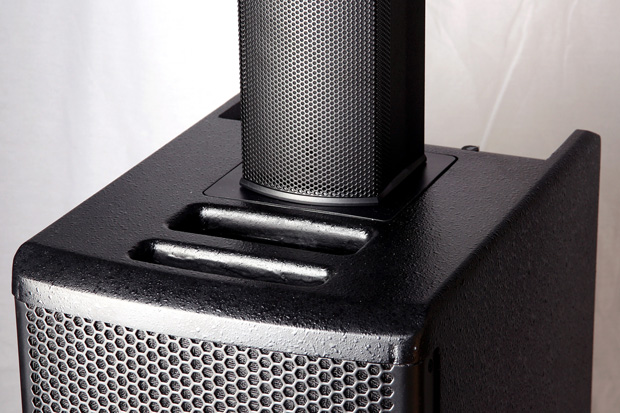 Pro & Contra
Pro & Contra
+ Design
+ Weight
+ Full sound
+ Price
+ System advantages (line array)
– No possibility for direct connection of microphones
Manufacturer response
The headline “Sounds good” says it all in a nutshell. With the compact and light MAUI 11, over the past 12 months, we have developed an elegant column system that should fit the budget of any musician or DJ. We made a conscious decision to do without a microphone input because of the wide range of affordable compact mixers available. That doesn’t mean, however, that we won’t consider including this feature and a few other add-ons in the next generation. We are very proud of this product and of the fact that it is even available before Christmas. Markus Jahnel / Sales Manager at ah
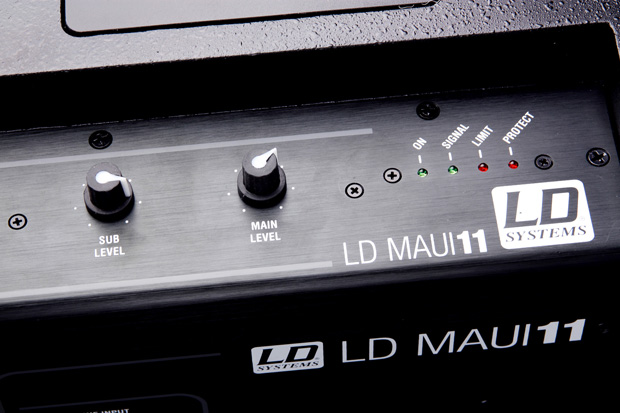 Facts
Facts
Manufacturer: LD Systems
Model: MAUI 11
Country of origin: China, developed in Germany
Type: 2.1 system (column speaker with subwoofer)
Column speaker: 8 x 3-inch + 1-inch horn tweeter
Dispersion: horizontal 120 degrees
Subwoofer: 2 x 6.5-inch, V design
Amplifier module: Class D, 340 W RMS, 680 W peak power output (RMS/peak)
Frequency response: 50 Hz – 20 kHz
Sensitivity: (1 W/1 m): 96 dB
Max SPL: 113 dB
Protection circuitry: Short circuit, overvoltage, dual limiter
Controls: Volume, subwoofer volume, on/off switch
Indicators; On, signal, limit, protect
Subwoofer connections: Input: 2 x XLR/6.3 mm, cinch; Output: 2 x XLR
Column connector: Multi-pin with sturdy pins (no cable required)
Subwoofer: 15-mm plywood with textured finish
Column speaker: Aluminium
Dimensions (W x H x D): Subwoofer 256 x 650 x 355 mm
Column speaker: 94 x 1310 x 95 mm
Height of complete system: 1950 mm
Weight: Subwoofer: 17.1 kg; Column speaker: 6.8 kg
For complete product information, go to:
http://www.ld-systems.com/405-1-ld-maui-11.html
Source: tools4music, Germany, November 2012
Leave a Comment
You must be logged in to post a comment.












